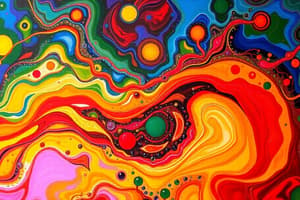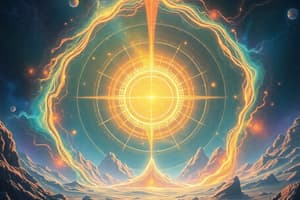Podcast
Questions and Answers
According to the second law of thermodynamics, every energy transfer increases the entropy of the universe. How do living organisms maintain their organization in light of this?
According to the second law of thermodynamics, every energy transfer increases the entropy of the universe. How do living organisms maintain their organization in light of this?
- By converting entropy into usable energy.
- By isolating themselves from their surroundings.
- By creating energy through metabolic processes.
- By increasing the entropy of their surroundings. (correct)
A biochemist is studying a reaction and finds that it has a positive ΔG. Which of the following is true regarding this reaction?
A biochemist is studying a reaction and finds that it has a positive ΔG. Which of the following is true regarding this reaction?
- The reaction will proceed without any external influence.
- The reaction requires energy input to occur. (correct)
- The reaction is at equilibrium.
- The reaction is spontaneous and releases energy.
During strenuous exercise, muscle cells may switch to lactic acid fermentation. How does this process allow glycolysis to continue under anaerobic conditions?
During strenuous exercise, muscle cells may switch to lactic acid fermentation. How does this process allow glycolysis to continue under anaerobic conditions?
- By breaking down lactic acid into pyruvate.
- By regenerating NAD+ from NADH. (correct)
- By producing additional ATP directly.
- By providing oxygen to the electron transport chain.
Which of the following is the primary role of the electron transport chain in cellular respiration?
Which of the following is the primary role of the electron transport chain in cellular respiration?
In photosynthesis, both the light-dependent reactions and the Calvin cycle are essential. What is the primary function of the light-dependent reactions?
In photosynthesis, both the light-dependent reactions and the Calvin cycle are essential. What is the primary function of the light-dependent reactions?
Enzymes are biological catalysts that increase the rate of biochemical reactions. How do enzymes achieve this?
Enzymes are biological catalysts that increase the rate of biochemical reactions. How do enzymes achieve this?
What is the role of $NAD^+$ in cellular respiration?
What is the role of $NAD^+$ in cellular respiration?
Which of the following best describes the process of chemiosmosis in oxidative phosphorylation?
Which of the following best describes the process of chemiosmosis in oxidative phosphorylation?
Feedback inhibition is a common mechanism for regulating metabolic pathways. How does it work?
Feedback inhibition is a common mechanism for regulating metabolic pathways. How does it work?
During glycolysis, glucose is converted into pyruvate. Where does glycolysis take place in eukaryotic cells?
During glycolysis, glucose is converted into pyruvate. Where does glycolysis take place in eukaryotic cells?
Flashcards
Bioenergetics
Bioenergetics
Study of energy flow through living systems, including energy production, storage, and utilization within cells and organisms.
Gibbs free energy (G)
Gibbs free energy (G)
Energy available to do work in a system at constant temperature and pressure.
Adenosine Triphosphate (ATP)
Adenosine Triphosphate (ATP)
Primary energy currency of the cell, consisting of adenine, ribose, and three phosphate groups.
Metabolic pathways
Metabolic pathways
Signup and view all the flashcards
Enzymes
Enzymes
Signup and view all the flashcards
Redox Reactions
Redox Reactions
Signup and view all the flashcards
Cellular Respiration
Cellular Respiration
Signup and view all the flashcards
Electron Transport Chain (ETC)
Electron Transport Chain (ETC)
Signup and view all the flashcards
Chemiosmosis
Chemiosmosis
Signup and view all the flashcards
Photosynthesis
Photosynthesis
Signup and view all the flashcards
Study Notes
- Bioenergetics is the study of energy flow through living systems
- It involves energy production, storage, and utilization within cells and organisms
- It is central to understanding metabolism, the sum of all chemical reactions in a cell or organism
Energy and Thermodynamics
- Energy is the capacity to do work
- Thermodynamics governs energy transformations in biological systems
- The first law of thermodynamics states energy cannot be created or destroyed, only converted
- The second law of thermodynamics states that every energy transfer increases entropy (disorder)
- Living organisms must increase the entropy of their surroundings to maintain their organization
- Gibbs free energy (G) is the energy available to do work at constant temperature and pressure
- Change in Gibbs free energy (ΔG) determines the spontaneity of a reaction:
- A negative ΔG indicates a spontaneous (exergonic) reaction, releasing energy
- A positive ΔG indicates a non-spontaneous (endergonic) reaction, requiring energy input
- A ΔG of zero indicates a reaction at equilibrium
ATP: The Energy Currency of the Cell
- Adenosine triphosphate (ATP) is the primary energy currency of the cell
- ATP consists of adenine, ribose, and three phosphate groups
- The bonds between phosphate groups are high-energy bonds
- Hydrolysis of ATP to ADP (adenosine diphosphate) and inorganic phosphate (Pi) releases energy
- This energy drives endergonic reactions in the cell
- ATP can also be hydrolyzed to AMP (adenosine monophosphate) and pyrophosphate (PPi); PPi is further hydrolyzed to 2 Pi
- ATP is regenerated from ADP and Pi through cellular respiration and photosynthesis
- The ATP cycle involves continuous ATP hydrolysis and regeneration to power cellular activities
Metabolic Pathways
- Metabolic pathways are series of interconnected chemical reactions
- Each reaction is catalyzed by a specific enzyme
- Pathways can be linear, branched, or cyclic
- Catabolic pathways break down complex molecules into simpler ones, releasing energy (exergonic)
- Anabolic pathways build complex molecules from simpler ones, requiring energy (endergonic)
- Catabolism provides the energy and building blocks for anabolism
Enzymes and Catalysis
- Enzymes are biological catalysts that speed up chemical reactions
- Most enzymes are proteins
- Enzymes lower the activation energy of a reaction, making it more likely to occur
- Enzymes are highly specific for their substrates
- The active site is the region of the enzyme where the substrate binds and catalysis occurs
- Enzyme activity can be regulated by various factors:
- Temperature: Enzymes have an optimal temperature range
- pH: Enzymes have an optimal pH range
- Substrate concentration: Increasing substrate concentration increases reaction rate up to a saturation point
- Inhibitors: Inhibitors can decrease enzyme activity (competitive or noncompetitive)
- Activators: Activators can increase enzyme activity
Oxidation-Reduction Reactions (Redox Reactions)
- Redox reactions involve the transfer of electrons from one molecule to another
- Oxidation is the loss of electrons
- Reduction is the gain of electrons
- Redox reactions always occur together: one substance is oxidized while another is reduced
- Electron carriers, such as NAD+ and FAD, play a crucial role in redox reactions
- NAD+ (nicotinamide adenine dinucleotide) accepts electrons and becomes NADH
- FAD (flavin adenine dinucleotide) accepts electrons and becomes FADH2
- NADH and FADH2 carry electrons to the electron transport chain for ATP production
Cellular Respiration
- Cellular respiration is the process by which cells break down organic molecules to produce ATP
- It includes glycolysis, the citric acid cycle (Krebs cycle), and oxidative phosphorylation
- Glycolysis occurs in the cytoplasm and converts glucose into pyruvate, producing a small amount of ATP and NADH
- The citric acid cycle occurs in the mitochondrial matrix and oxidizes pyruvate to CO2, producing ATP, NADH, and FADH2
- Oxidative phosphorylation occurs in the inner mitochondrial membrane and uses the electron transport chain and chemiosmosis to produce a large amount of ATP
Electron Transport Chain and Chemiosmosis
- The electron transport chain (ETC) is a series of protein complexes that transfer electrons from NADH and FADH2 to oxygen
- Electrons are passed from one complex to another, releasing energy
- This energy is used to pump protons (H+) from the mitochondrial matrix to the intermembrane space, creating an electrochemical gradient
- Chemiosmosis is the movement of H+ ions down their electrochemical gradient through ATP synthase
- ATP synthase uses the energy from H+ flow to phosphorylate ADP to ATP
- Oxidative phosphorylation produces the majority of ATP in cellular respiration
Photosynthesis
- Photosynthesis is the process by which plants, algae, and some bacteria convert light energy into chemical energy in the form of glucose
- It occurs in chloroplasts
- Photosynthesis includes the light-dependent reactions and the Calvin cycle (light-independent reactions)
- The light-dependent reactions occur in the thylakoid membranes and use light energy to split water, producing ATP, NADPH, and oxygen
- The Calvin cycle occurs in the stroma and uses ATP and NADPH to fix carbon dioxide into glucose
Anabolic Pathways Examples
- Gluconeogenesis is the synthesis of glucose from non-carbohydrate precursors
- Protein synthesis involves building proteins from amino acids
- Nucleic acid synthesis involves building DNA and RNA from nucleotides
Regulation of Metabolic Pathways
- Metabolic pathways are tightly regulated to maintain cellular homeostasis
- Regulation can occur at several levels:
- Enzyme activity: Allosteric regulation, feedback inhibition
- Enzyme synthesis: Gene expression control
- Compartmentalization: Separating pathways in different cellular compartments
- Hormonal control: Insulin and glucagon regulate glucose metabolism
- Feedback inhibition is a common regulatory mechanism where the end product of a pathway inhibits an earlier step in the pathway
Studying That Suits You
Use AI to generate personalized quizzes and flashcards to suit your learning preferences.




